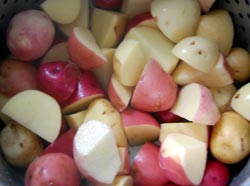How to Grow Potatoes for a Tasty Organic Crop
Here's how to grow potatoes - an easy guide for organic home growers
Why not learn to grow potatoes? It's easy and good fun, provided that you keep it simple. Here are some straightforward ways to grow potatoes a home.
 Picture above: potato flowers are quite pretty, too - another benefit of growing potatoes |
You can have your own, tasty, organic spuds fresh from the garden all summer long.
Nothing is as delicious as fresh new potatoes with a sprig of mint and a dab of butter! The humble potato can make quite a gourmet dish served with fresh greens from the garden.
You can even grow some to store through the winter.
If you have enough space in your garden it can be worthwhile growing a fair few, especially as the price of food is rising. Potato storage is easy if you have the space.
An easy crop that helps clear the ground
Potatoes are one of the easiest starter crops for the novice gardener. At the very easiest, you could just pull back some soil and pop in some seed potatoes and be fairly sure that you will have a crop in a few months. You will get a crop - but it's unlikely to be large because of competing weeds.
One of the brilliant things about potatoes is that they help clear ground for other crops, so it is not even essential to have well-tilled ground. Even so, you stand to get a better, cleaner harvest if your soil is clear of weeds and larger stones.
Here's how to be reasonably sure you get a worthwhile harvest of tasty and nutritious organic potatoes with minimal work.
How to grow potatoes:
Give them plenty of space
Potatoes do need plenty of space and light to grow well. You do need to plan for this. They will not grow well in cramped conditions. The traditional potato growing method of using wide adjacent rows does make sense for most people. Prepare the ground as well as you can by clearing out the more aggressive weeds. A liberal addition of well rotted manure or compost will help to assure good growth. For best results fork in the manure so that it is well mixed with the soil.
You should not put them in soil where tomatoes were recently grown. They are both Solanum family plants and so suffer from some of the same diseases. Even though they need space, they can do well on the patio in containers.
How to grow potatoes:
Choose good seed
Buy one or two varieties of seed potatoes in early spring. Choose an "early" and a mid-season (maincrop) or late variety in order to get spuds ready to dig up over several months. If you've only room for one type, an early is best. You can use them as you dig them up and use the ground for something else later. You also need to choose between salad and roasting potatoes. Salad potatoes tend to be waxy. The best roasters are more floury in texture (e.g King Edward, Maris Piper).
Store the seed potatoes in a dry, cool place until you are ready to use them. You do not need to "chit" them. A recent study showed that it makes little or no difference to the quality and size of the crop. (Chitting is the process of setting seed potatoes to grow in a cool space before planting.)
How to grow potatoes:
Timing and soil conditions
Remove weeds and make sure the soil is warm enough - around 7 degrees Centigrade or better. You can plant some very early, even in February if you are prepared to cover the crowns with straw or fleece. Only do this if you have a sheltered spot and the season seems to be warm. Frost can kill young potatoes. Even if it does not kill them it will set them back considerably.
Dig a trench about 10 - 15 cms deep (4 - 6 inches). Place a whole potato every 25 - 30 cms or so. If the potato has lots of sprouting "eyes" you can either rub off all but two, or you can cut it in two and use both halves. Place the potatoes so that the eyes (or sprouts, if they have sprouted) are facing upwards. If the conditions are dry it will help to give the potatoes and soil a good soaking.
Pull the soil back over the row of spuds and firm it down without compacting the soil. Put the next row a good two feet away (60 cms). Add some compost to the soil for best results.
When the potatoes show strong green leaves pushing though the soil, draw more soil up to the crown of the plants. (Don't bury them; wait until they are about 6 or 8 inches high and draw the soil up around them. This helps more tubers to grow near the surface - a heavier crop and easier to harvest. Remove weeds as you go. Potatoes are big and will out-compete many weeds but they still need some help. You can earth them up to form a ridge about 6 inches high.
You can repeat this process a few times as they grow.
Feeding your growing potatoes
If you have prepared the soil well and it is already rich you may not need extra feed. However, potatoes are similar to tomatoes in that they like a high potash feed. Minced up comfrey leaves can supply a good amount of potash. Seaweed based products such as Maxicrop are also valuable. Rotted vegetable waste from your compost bin is also a good high potash input for growing potatoes.
How to grow potatoes:
When and how to harvest
The potato crop will be ready to harvest around the time that flowers appear on the plants. You can harvest at this time for new potatoes or you can wait a bit longer until the "haulm" starts to die back. Scoop potatoes out with a trowel or small fork if the ground is damp. In drier weather you will need to lever them out with a fork, risking some loss from puncturing. Start from well outside the plant's border to minimise this.
Remove all the potatoes as thoroughly as possible as you don't want potatoes coming up next year when you are trying to grow something different. Don't leave your potatoes in the soil longer than necessary as you risk pests attacking them.
If you harvest enough potatoes to warrant storing them, put them into paper sacks and keep them in a cool, dry place away from vermin. Check them from time to time for rot and remove any affected ones.
Only store healthy, undamaged potatoes. Use up first the ones you sliced through with the fork when you dug them up. (It always happens!)
How to grow potatoes:
Using containers
Potatoes can be grown successfully in containers. A double ring of old tyres is quite an easy way. Fill the tyres with good compost or soil. Add some good seed potatoes. Keep them well watered. The black rubber of the tyres helps warm the soil in early spring. An old window or similar will help it warm up even more. Make sure that any glass you use is safety glass.
You can also use this method with deep recycled containers, such as have stored organic fertiliser.
Drill some drainage holes, add some crocks or pebbles to help the free draining of water. Add soil and compost. Fill the tub only about half full. Add the spuds. Add more compost and soil mix and away you go! If you keep them in the greenhouse, or if there is a dry spell, remember to water them adequately.
You can also buy purpose made containers for potatoes, which are a bit like deep grow bags. I've tried this and it works quite well. It helps to keep the growing potatoes close to the water butt or tap so that watering is easy. I've not yet achieved the results that are claimed in the product blurb... but maybe next year!
Once you've experienced how to grow potatoes successfully, there are recipe pages for organic homegrown potatoes here:
Easy cheesy potatoes recipe page.

Picture above: how to grow potatoes - the results!

Custom Search
Greenfootsteps Home - for more easy green living ideas
How to Grow Potatoes
Copyright Greenfootsteps.com 2010
Please do not copy without permission. This site is protected by Copyscape

| Tweet |

Footprints
- an occasional e-zine from Greenfootsteps
If you would like to receive the e-zine, please just sign up below.






New! Comments
Have your say about what you just read! Leave me a comment in the box below.